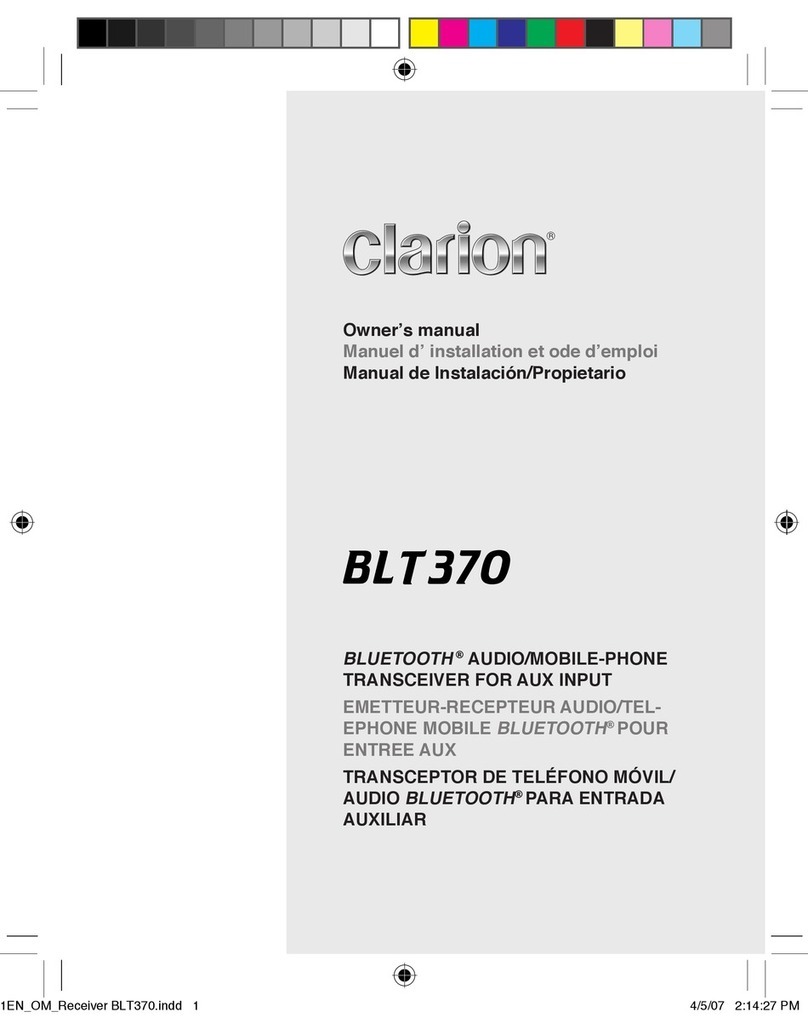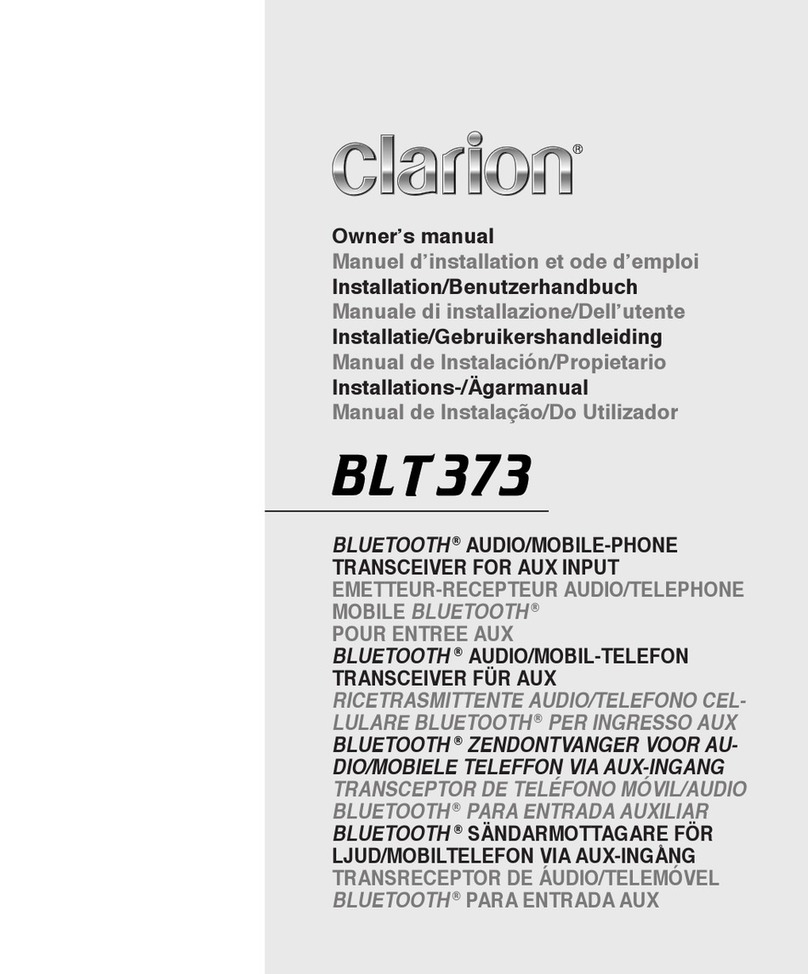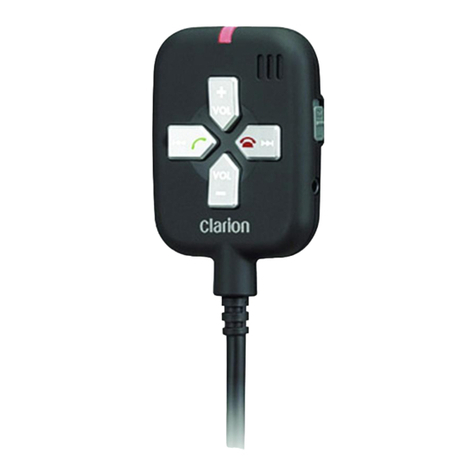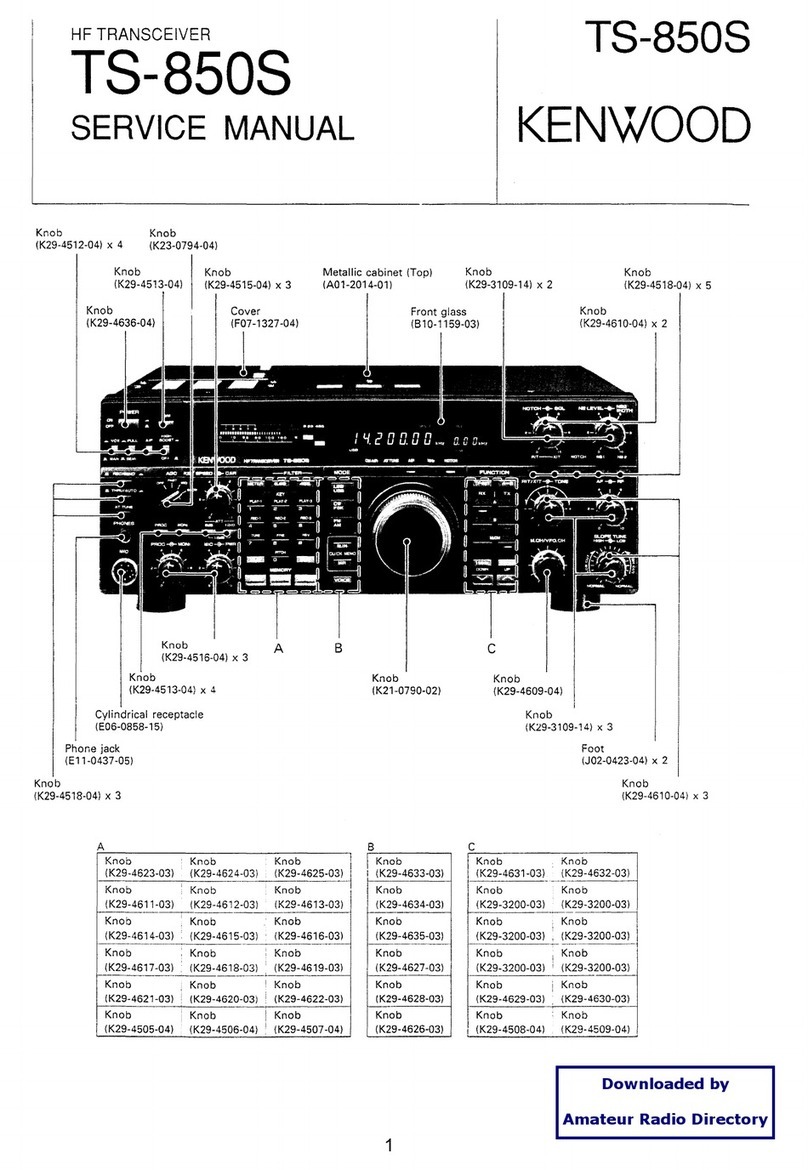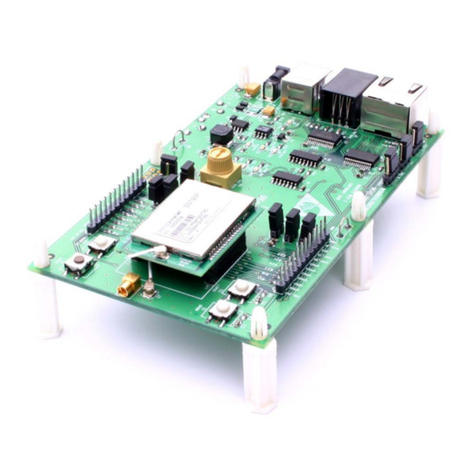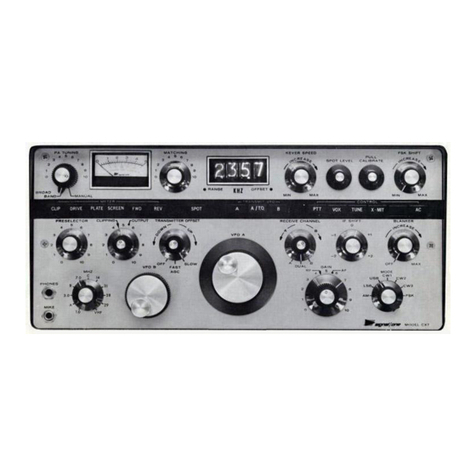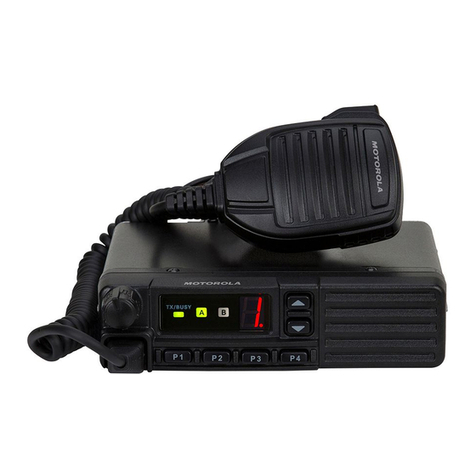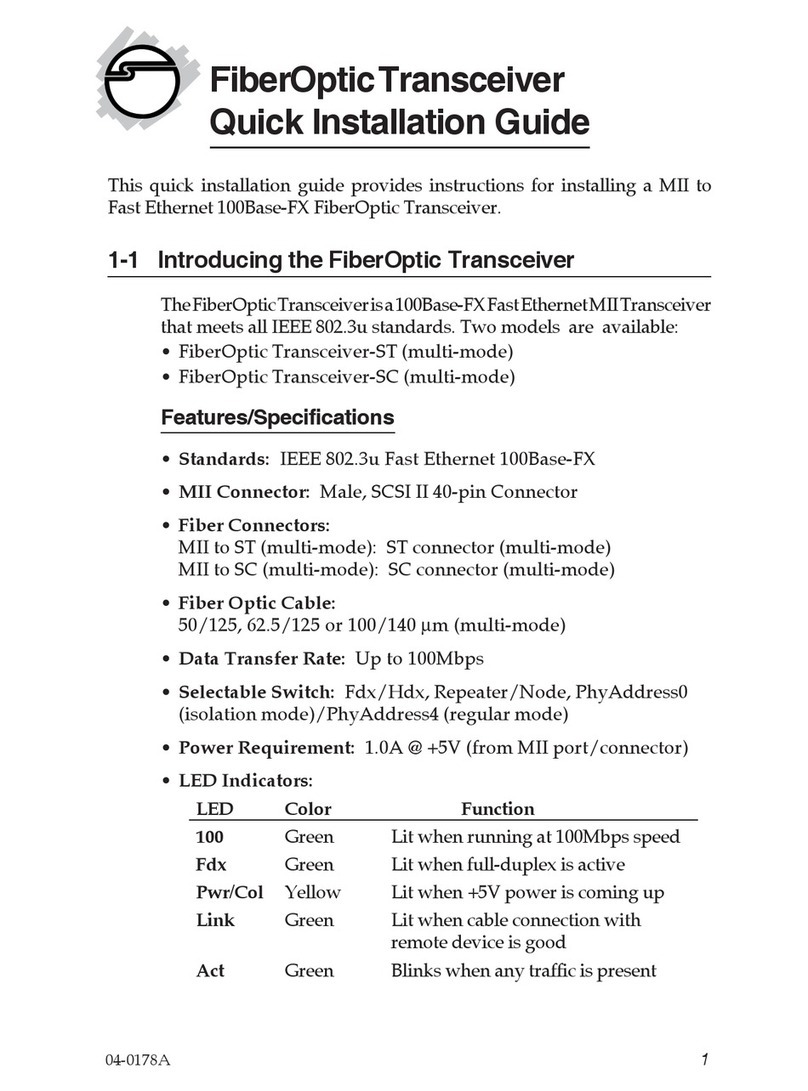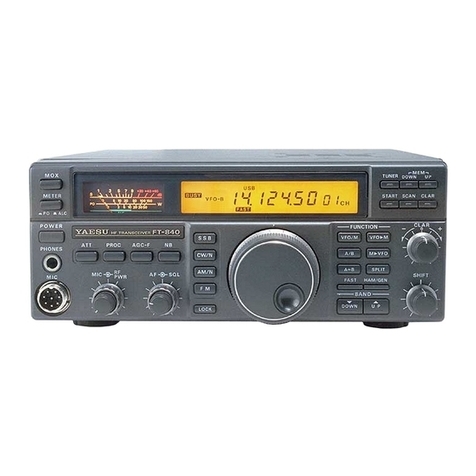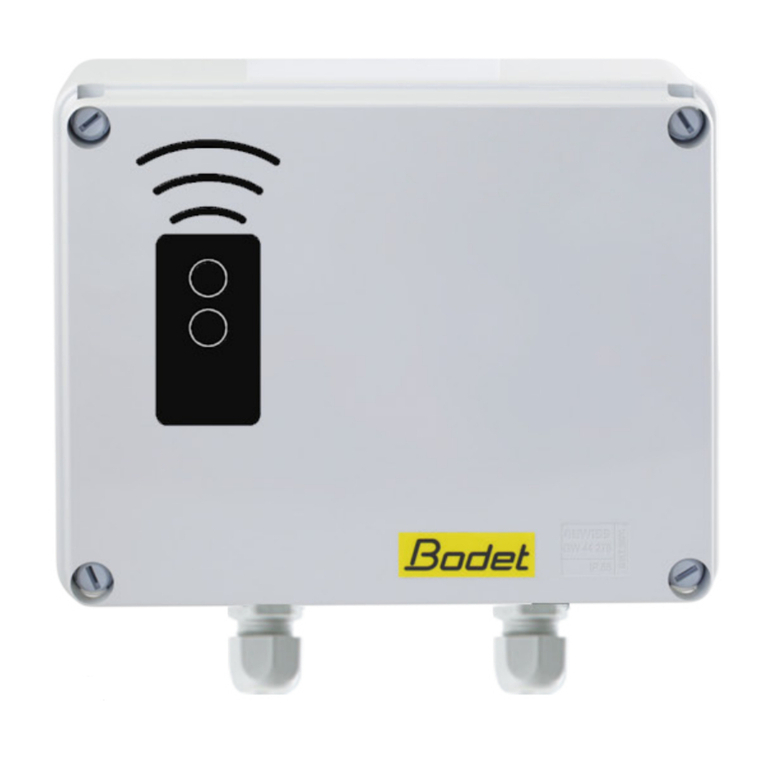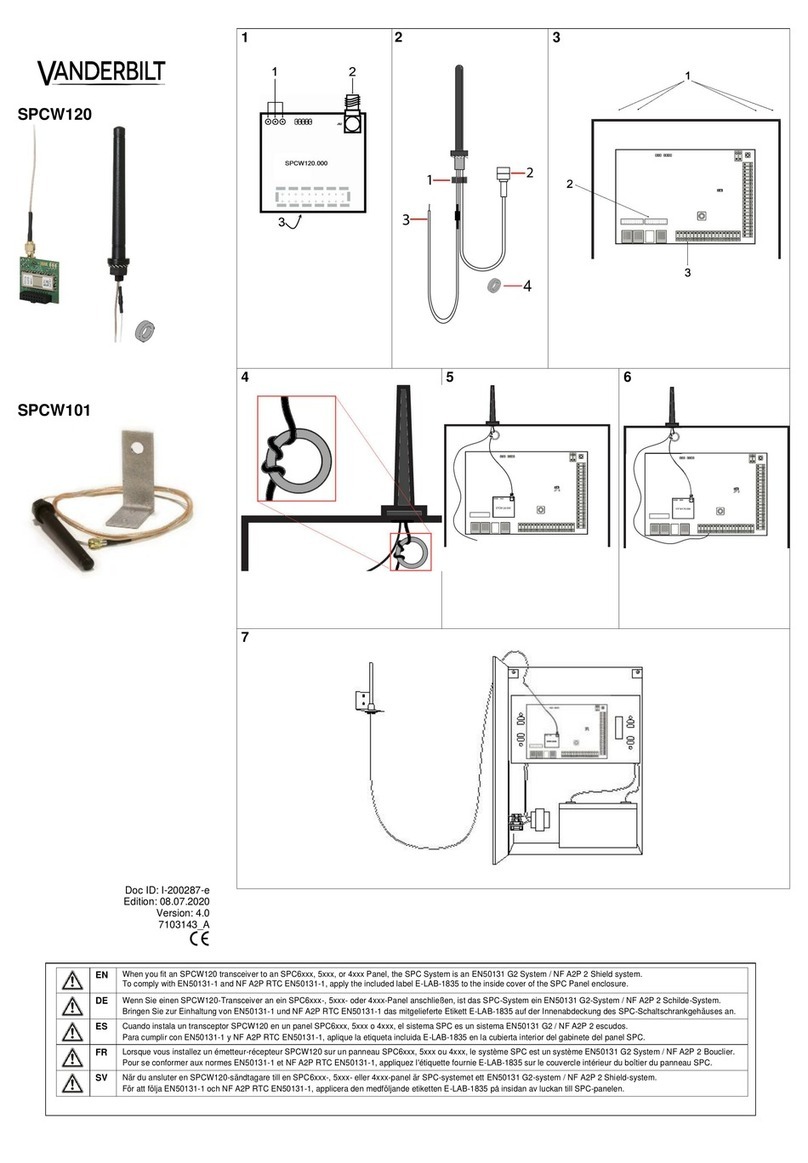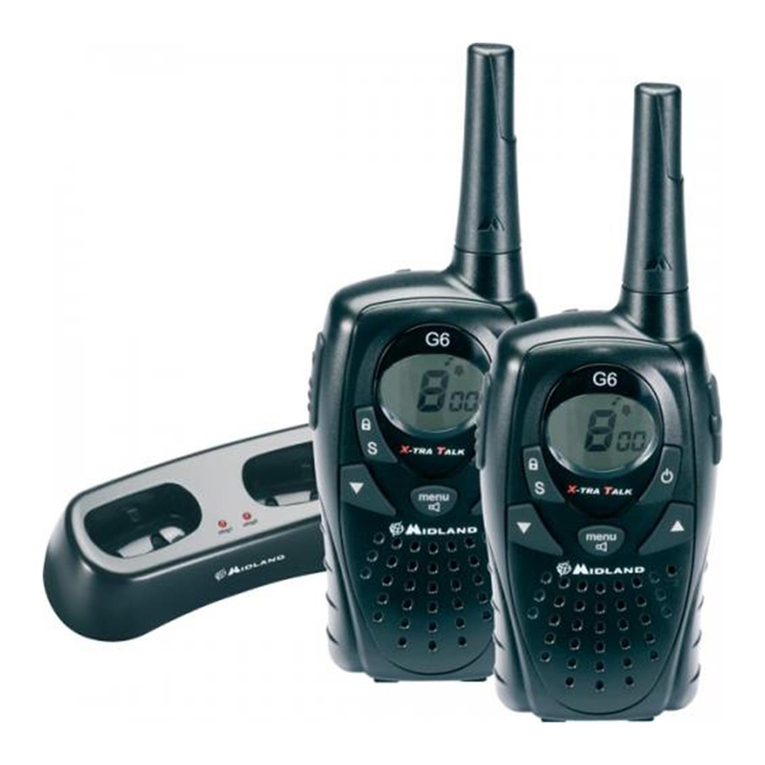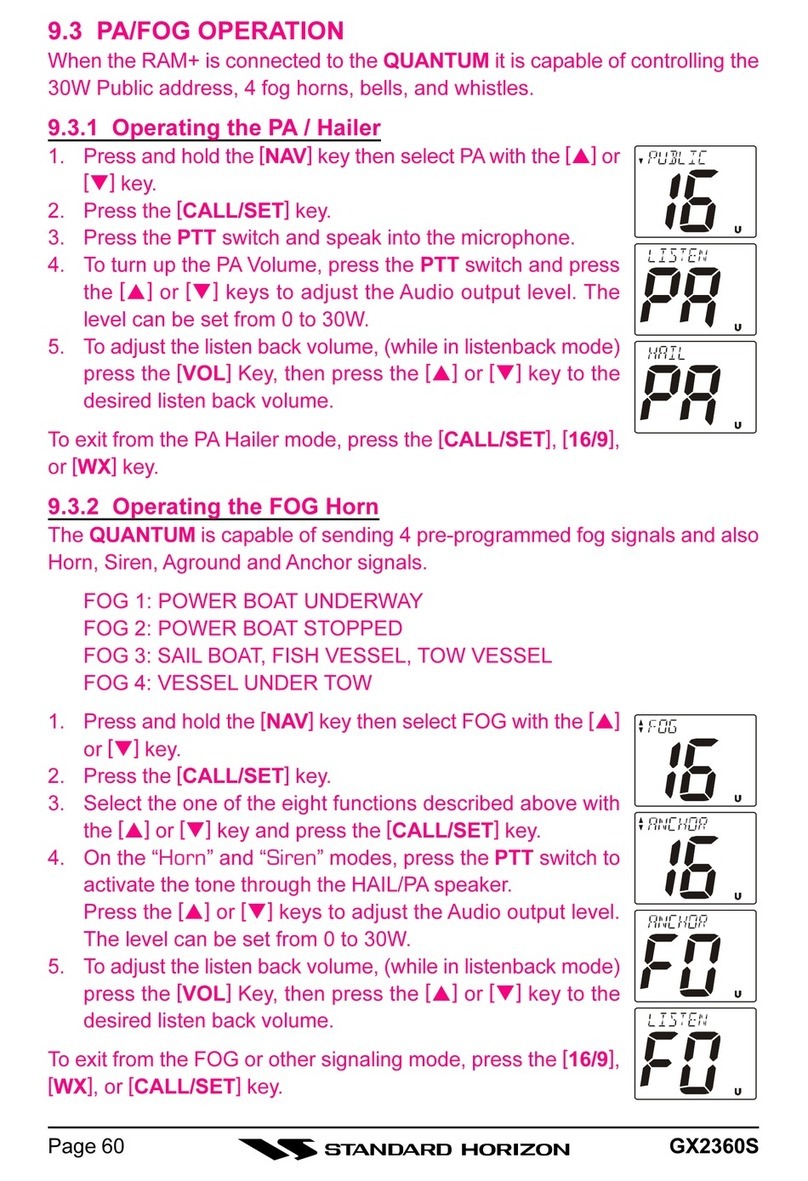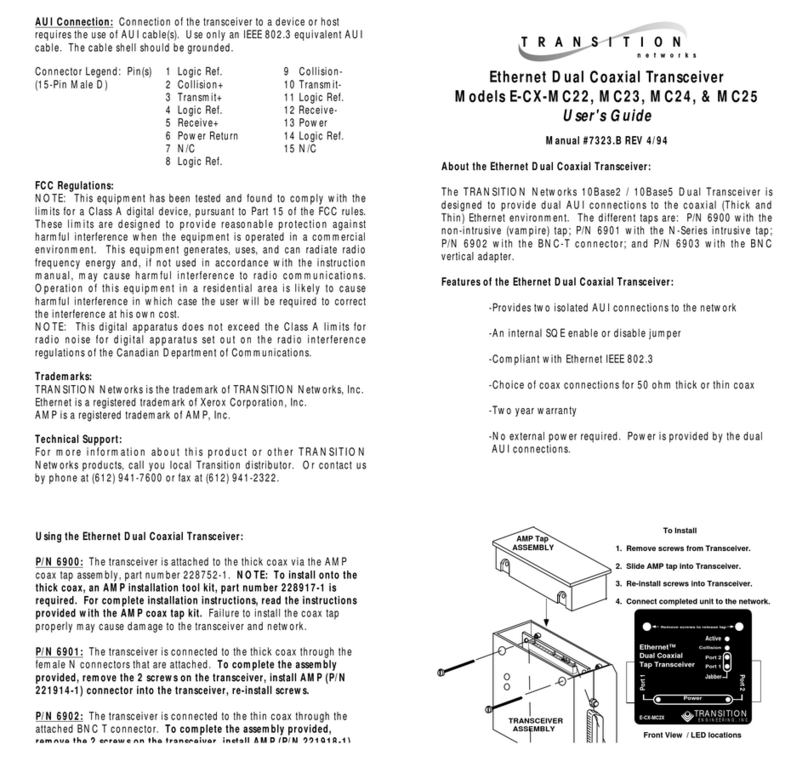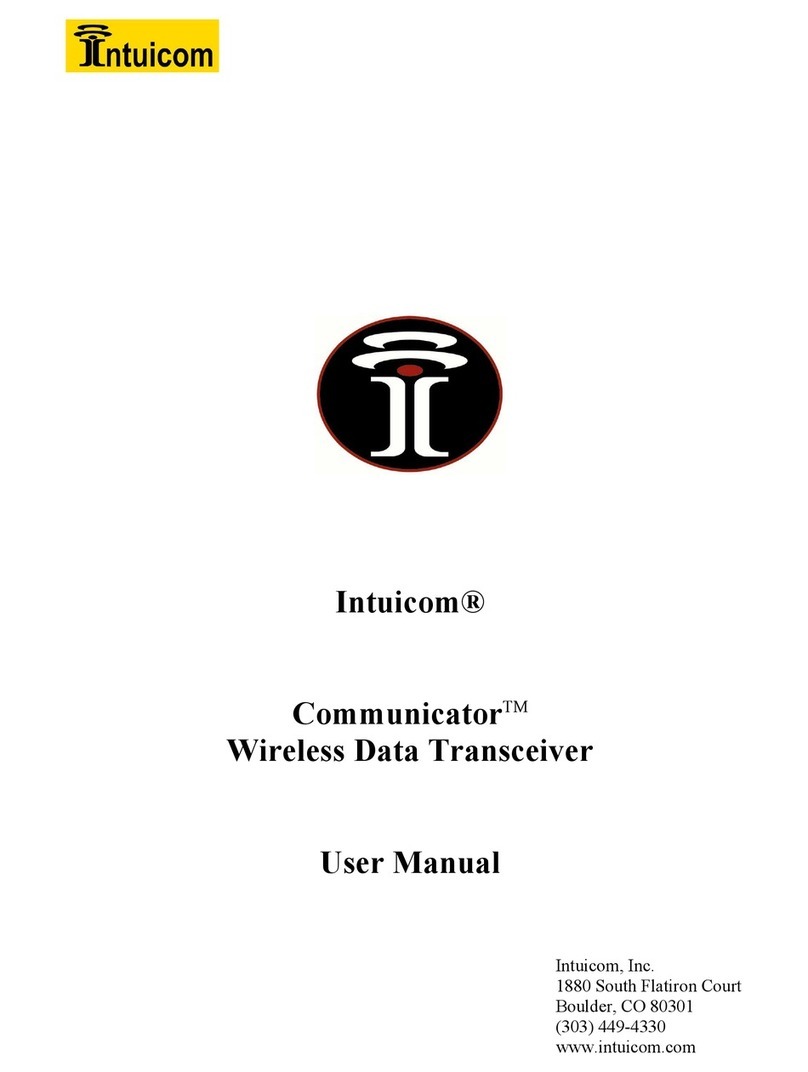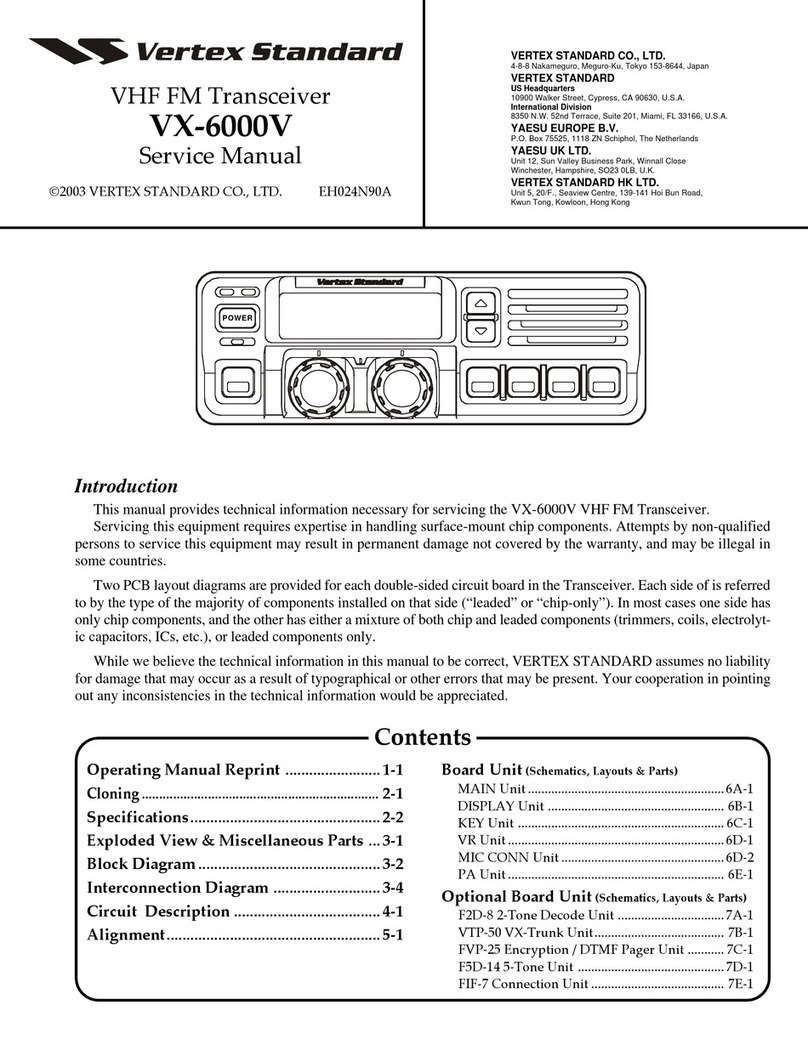Clarion M10 Series User manual

M10 Series User’s Manual
Rev. 1
10Mbps SPREAD SPECTRUM
WIRELESS TRANSCEIVERS

CLARION M10 SERIES
M10 SERIES USER’S MANUAL PAGE II
NOTICES
FCC
Models, JX-4000F-A, JX4000F-C, JX4000W-A and JX4000W-C comply with
Part 15 of the FCC Rules. Operation is subject to the following two conditions: (1)
This device may not cause harmful interference, and (2) This device must accept
any interference received, including interference that may cause undesired
operation.
Removing covers from of the radio(s) nullifies the FCC compliance and can be the
cause of spurious transmission, RF noise and out of band transmission levels
above FCC regulations.
Warning
The manufacturer assumes no responsibility for damage caused by interference
due to this equipment.
The information in this document is preliminary. The manufacturer assumes no
responsibility for any errors that may appear in this document.
Ethernet and Ethernet II are trademarks of Xerox.
LANalyzer is a registered trademark of Novell, Inc.
Copyright
Copyright © 1996, Clarion Corporation of America. All rights reserved. No part
of the contents of this document may be transmitted or reproduced in any form or
by any means without the written permission of Clarion Corporation of America.
Patent
United States Patent Number 5,809,060, issued September 15, 1998.
Taiwan Patent Number 073357.
Singapore Patent Number 52170.
South Africa Patent Number 95/1282.

CLARION M10 SERIES
M10 SERIES USER’S MANUAL PAGE III
TABLE OF CONTENTS
1. INTRODUCTION __________________________________________________ 1
1.1 Welcome______________________________________________________________1
1.1.1 M10 _____________________________________________________________________ 1
1.1.2 M10II____________________________________________________________________ 1
1.2 Summary of Features ___________________________________________________3
1.2.1 FEATURES OF ALL M10 MODEMS __________________________________________ 3
1.2.2 ADDITIONAL FEATURES OF THE M10II _____________________________________ 3
2. STRUCTURE _____________________________________________________ 4
2.1 Block Diagram_________________________________________________________4
2.2 Description of Block Diagram ____________________________________________4
2.3 Principles of Operation__________________________________________________7
2.3.1 UPLOAD PROCESS________________________________________________________ 7
2.3.2 DOWNLOAD PROCESS ____________________________________________________ 8
2.3.3 BUFFER MEMORY ________________________________________________________ 9
2.3.4 FORWARD ERROR CORRECTION (FEC) _____________________________________ 9
2.3.5 RE-TRANSMISSION_______________________________________________________ 9
2.3.6 SECURITY ______________________________________________________________ 12
2.3.7 ANTENNA DIVERSITY ___________________________________________________ 12
2.3.8 ANTENNA RECOGNITION (ANTENNA SENSE CIRCUIT)______________________ 13
2.3.9 ANTENNA POINTING ____________________________________________________ 14
2.3.10 RANGE OF OPERATION________________________________________________ 14
2.3.11 POSITIONING_________________________________________________________ 15
2.3.11.1 Co-Location of M10 Units______________________________________________ 15
2.3.12 CHANNEL ACCESS PROTOCOL _________________________________________ 16
3. APPEARANCE ___________________________________________________ 17
3.1 Dimensions___________________________________________________________17
3.2 Weight ______________________________________________________________17
3.3 Front and Rear Panel __________________________________________________17
4. SPECIFICATIONS________________________________________________ 18
4.1 General______________________________________________________________18
4.2 Radio _______________________________________________________________19
4.3 Network _____________________________________________________________20
4.4 Port_________________________________________________________________21
4.4.1 MAU PORT______________________________________________________________ 21
4.4.1.1 Pin Assignment ______________________________________________________ 21
4.4.1.2 Absolute Maximum Ratings of the Driver (An7992B) _________________________ 22
4.4.1.3 Transformer (ST7032)_________________________________________________ 22
4.4.2 DC 6.2V PORT ___________________________________________________________ 22
4.4.2.1 Power Requirement ___________________________________________________ 22
4.4.2.2 Power Jack Requirement_______________________________________________ 23
4.5 LED Display _________________________________________________________24

CLARION M10 SERIES
M10 SERIES USER’S MANUAL PAGE IV
4.6 Emissions ____________________________________________________________25
4.7 Environmental________________________________________________________25
4.8 Spectrum Mask_______________________________________________________26
5. CONFIGURATION _______________________________________________ 27
5.1 Default Settings_______________________________________________________27
5.2 Configuration Commands ______________________________________________27
5.3 Configuration Parameters ______________________________________________29
6. COMPLIANCE WITH STANDARDS_________________________________ 33
6.1 MAU________________________________________________________________33
6.1.1 BUFFER DELAY _________________________________________________________ 33
6.1.2 FLOW CONTROL ________________________________________________________ 33
7. RECOMMENDED TEST PROCEDURE ______________________________ 35
7.1 Testing Procedure_____________________________________________________35
7.2 SPECIAL FEATURES OF THE M10II___________________________________36
7.2.1 INTRODUCTION TO TESTING THE M10II ___________________________________ 36
7.3 Testing Throughput ___________________________________________________42
7.3.1 DEFINITION OF THROUGHPUT____________________________________________ 42
7.3.2 SETUP FOR MEASURING THE THROUGHPUT _______________________________ 42
7.3.3 MEASURING PROCEDURE OF THROUGHPUT_______________________________ 43
8. CUSTOMER ASSISTANCE_________________________________________ 45
9. GLOSSARY ______________________________________________________ 47

CLARION M10 SERIES INTRODUCTION
M10 SERIES USER’S MANUAL PAGE 1
1. INTRODUCTION
1.1 Welcome
Welcome to Clarion’s world of wireless LAN (Local Area Network)
products. The M10 family of products currently include the M10 (Models
JX-4000FA, JX-4000F-C and JX-4000F-S), and the M10II (Models JX-
4000W-A, JX-4000W-C, and JX4000W-S.
The M10 is a wireless multi-point modem, the M10II is an extension of
this multi-point modem to multi-source address situations, it can
accommodate up to 200 NICs (Network Interface Cards) per network
segment, and maintains its own internal tables.
1.1.1 M10
The M10 is a robust, 10 Mbps (Megabits Per Second) wireless single
address, multi-point modem designed to support wireless connections
across town, across the street or just across the hall for IEEE 802.3 and
Ethernet II (TCP/IP) LANs. It provides all the functionality of a wired
LAN, without the physical constraints of the wire.
The M10 uses state-of-the-art spread spectrum technology, which provides
secure, long-range radio link operations for reliable transmission.
The M10 is compatible with all computer platforms, operating systems and
network protocols. It is pre-configured to operate right out of the box, just
connect the M10 to your existing Ethernet card and use your existing
network software. The M10 functions as an Ethernet Medium Attachment
Unit (MAU) encapsulating the Medium Access Control (MAC) frames
from a standard Auxiliary Unit Interface (AUI) port to form a Radio
Frequency (RF) MAC frame.
The M10 can be connected to a computer, hub or router and can be used to
create innovative LANs by combining existing wired devices with the M10
units without sacrificing speed or accuracy.
1.1.2 M10II
The M10II is the second generation Clarion product in the M10 family.
The M10II offers all the functions and features of the original M10 modem,
as well as providing an important additional advantage to customers. The

CLARION M10 SERIES INTRODUCTION
M10 SERIES USER’S MANUAL PAGE 2
upgraded feature of the M10II is the extension of retransmission protocol to
multi-source address situations.
This key new feature of the M10II required substantial development. In
wired communications frames are lost mainly by collisions. However, in
wireless communications frames can be lost by fading, weak signals or
interference. Thus, all radio modems require lower level retransmission of
frames to provide adequate reliability and throughput. The original M10
was designed for connection to a single Ethernet card, either in a
workstation or a router. Both the workstation and the router employ a
single 802.3 source address that the M10 learns and uses for the
retransmission protocol. Thus, when the M10 receives a frame with the
destination address equal to the address of the attached Ethernet card, the
M10 sends the RF acknowledgment frame to the source modem. The
M10II can do this for multiple Ethernet source addresses.
There are two important situations in which the above single-source-
address constraint is violated: 802 MAC (media access control) level
bridging and wireless interconnection of 10BaseT hubs. Each of these is
important for general networking, and each presents the modem with
multiple source addresses from the wired side. The M10II maintains a list
of its wired side source addresses, and will acknowledge RF frames
addressed to these. Thus, the key new feature of the M10II is extension of
the retransmission protocol to multi-source-address configurations.
The M10II maintains acknowledgment-address tables, however, it is not a
bridge. For 802-compliant bridging the M10II can be connected to a MAC
bridge, with the MAC bridge providing address tables obtained via the
spanning-tree algorithm.

CLARION M10 SERIES INTRODUCTION
M10 SERIES USER’S MANUAL PAGE 3
1.2 Summary of Features
1.2.1 FEATURES OF ALL M10 MODEMS
•10 Mbps Wireless Multi-Point Modem
•Plugs into AUI port of a hub, media converter or router
•Simple to install
•Adapts immediately without user intervention
•High Throughput at the MAC (Media Access Control) layer
•Compatible with all IEEE 802.3 and Ethernet II LAN devices, all
operating systems and all protocol stacks
•Completely transparent to the network operating system
•Secure Direct Sequence Spread Spectrum (DSSS) Technology
•Provides all the functionality of wired LANs without the wire
•No FCC License is required
1.2.2 ADDITIONAL FEATURES OF THE M10II
•Automatically senses local traffic, builds internal tables and
operates re-transmission and packet filtering protocols
•Accommodates up to 200 NICs per network segment

CLARION M10 SERIES STRUCTURE
M10 SERIES USER’S MANUAL PAGE 4
2. STRUCTURE
2.1 Block Diagram
The following is a block diagram of the M10.
Figure 2.1
MAU
Driver
AUI/FIFO
Interface
&
Control
TX/RX
FIFO
FEC
Encoder/
Decoder MODEM
T/R
SW
Power
Amp
LNA IF Amp
Up/
Down
Converter
Main
µµP
ROM
RF
Modulator A/D
Converter
Down
Converter
RAM
EXT
ANT
MAU
DC
6.2V
Digital PCB
RF PCB
Rear Panel
Front Panel
LED
Local
OSC
TX Lo
RF Lo RX Lo
Voltage
Regulator
Each circuit
LED
Driver
Sub
µµP
Signal Flow of TX & RX signalsPower, Control, Display
Diversity
SW
2.2 Description of Block Diagram
MAU port: The AUI port of an Ethernet device connects to the MAU port
of the M10 through a transceiver cable (AUI cable). The connector type is
physically the same as for a standard MAU.
MAU Driver: Bi-directional driver to the MAU port.

CLARION M10 SERIES STRUCTURE
M10 SERIES USER’S MANUAL PAGE 5
AUI/FIFO Interface & Control: provides fast-in-fast-out buffer
management using TX/RX FIFO to minimize the degradation of the
throughput.
TX/RX FIFO: FIFO RAM managed by AUI/FIFO Interface & Control.
FEC Encoder/Decoder: Encoder and a decoder for efficient forward
error correction.
MODEM: generates baseband transmission signals corresponding to the
uploaded data stream or a control data generated by the Main µP. It also
regenerates the received data bit stream corresponding to the output of an
A/D Converter.
RF Modulator: modulates the IF (Intermediate Frequency) carrier by the
output of the MODEM.
Up/Down Converter: up-converts the modulated RF signal of the RF
Modulator to radio transmission signals in the 2.4 GHz band. It also down-
converts incoming RF signals of the 2.4 GHz band to IF signals.
Power Amp: amplifies the 2.4 GHz band signals up to transmit power.
RF SW: switches the signal flow from an antenna to a receiver or from the
Power Amp to the antenna.
Diversity SW: switches the antenna to use the internal antenna or the
external antenna, controlled by the Main µPto improve the reception under
the extreme fading environment.
Ext. Ant. port: The external antenna connects to this port. RF signals of
2436 MHz are transmitted or received. The connector type is a SMA
female.
LNA (Low Noise Amplifier): reduces the noise figure of the receiver to
obtain sufficient sensitivity.
Local OSC: provides local signals fed to the Up/Down Converter, to the
RF Modulator and to the Down Converter.
IF Amp: amplifies the IF (Intermediate Frequency) signal of 487 MHz,
enough to be handled by the A/D Converter.

CLARION M10 SERIES STRUCTURE
M10 SERIES USER’S MANUAL PAGE 6
Down Converter: regenerates baseband signals from IF signals fed to the
A/D Converter.
A/D Converter: converts analog baseband signals to digital signal stream
for the MODEM.
Main µµP(Microprocessor): controls the signal flow, hardware functions,
and the protocol.
DC 6.2V port: The output of the AC adapter connects to this port. This
voltage is tightly specified. Please contact to Clarion, if you want to use
alternate power sources.
LED: indicates operating situations of the M10. Please refer to
specifications for details.
Sub µµP: controls power fed to each circuit of the M10.

CLARION M10 SERIES STRUCTURE
M10 SERIES USER’S MANUAL PAGE 7
2.3 Principles of Operation
2.3.1 UPLOAD PROCESS
The Upload is defined as a data flow from an Ethernet device to the M10.
During Upload, it provides the following:
•Detection of preamble of the Ethernet frame followed by the
frame sync pattern.
•Suppression of the Ethernet preamble and frame sync for RF
transmission. (These portions of the frame are meaningless for
wireless transmission).
•Generation of a Collision signal if an Upload commences
while the AUI interface is busy; generation of the busy
Collision is selected through configuration setup. This enables
the M10 to force the Ethernet card into its exponential back-off
algorithm for flow control. If generation of the Collision is not
selected, then no Collision is generated but Uploadsare
ignored.
•Generation, when enabled through the configuration setup, of the
SQE (Signal Quality Error) test signal toward the MAU port.
•FEC-encoding, when FEC is enabled through configuration
setup.
•Generation of header information (RF MAC and RF physical
layer).
•Spread-spectrum carrier sense before transmission, with
preference given to reception. The M10 senses signals after
correlation, meaning that interference, such as microwave ovens
and different kinds of wireless LAN systems, cannot be sensed.
•Data and spread-spectrum modulation onto a carrier of 2.4 GHz
and RF transmission.

CLARION M10 SERIES STRUCTURE
M10 SERIES USER’S MANUAL PAGE 8
Figure 2.3.1 shows the encapsulation process described above.
Figure 2.3.1
Preamble F
SSourceDest. CRC
SourceDest.
RF MAC
Header
FEC Encoded Frame
RF PHY
Header
ACROSS MAU INTERFACE
IN TX FIFO
OUT OF FEC ENCODER
FROM MODEM
Standard
802.3 or
Ethernet II LLC data
L
or
P
MAC preamble & frame
sync are removed; RF
MAC header is added.
If FEC coding is
employed, then it
protects everything.
2.3.2 DOWNLOAD PROCESS
The Download is defined as a data flow from the M10 to an Ethernet
device. During Download, it provides the following:
•Detection of and time alignment to received radio signal.
•Demodulation of PHY header and MAC frame.
•FEC decoding when the M10 recognizes that the received frame
is FEC encoded by reading PHY header.
•Checking of 32-bit CRC (generated by an Ethernet card that
Uploaded the frame).
•Conversion of serial stream to bytes for storing in FIFO.
•Regeneration of the Ethernet preamble and frame sync.

CLARION M10 SERIES STRUCTURE
M10 SERIES USER’S MANUAL PAGE 9
•Detection of any collision condition for avoiding collision of the
Download to the Upload and signaling of such to the AUI
interface and to the CPU.
2.3.3 BUFFER MEMORY
A data transfer is called an Upload when the Ethernet device conveys a
frame to the buffer memory, and a Download when a frame is conveyed
from the buffer memory to the Ethernet device. The buffer memory is
organized as 16 2-Kbytes FIFOs, each FIFO being independently employed
and capable of storing a maximum-length Ethernet frame of 1518-bytes.
When all buffers are consumed, a Collision signal is generated to force the
Ethernet card into its exponential back-off algorithm for flow control. If
generation of the Collision is not selected, then no Collision is generated
but Upload(s) are ignored.
2.3.4 FORWARD ERROR CORRECTION (FEC)
The nominal transmission mode (uncoded mode) employs modulation
without FEC. The enhanced-robustness mode (coded mode) employs FEC
to overcome irreducible errors due to multi-path propagation condition.
The coded mode and/or selection of a diversity antenna can be selected by
the RF-MAC-level re-transmission protocol.
2.3.5 RE-TRANSMISSION
A re-transmission protocol at the RF MAC layer provides enhanced
reliability. The 32-bit CRC, checked by the 802.3 MAC layer to provide
ultimate data reliability, is also used to support the re-transmission protocol.
Figure 2.3.5 shows a conceptual signal flow diagram of the re-transmission.
The use of MAC-level re-transmission protocol, recommended by 802.11
draft standard, is important for high throughput. Re-transmission via the
level-four transport protocol must be avoided because of the long time-out
typically employed.

CLARION M10 SERIES STRUCTURE
M10 SERIES USER’S MANUAL PAGE 10
Prior to the re-transmission, the M10 recognizes and memorizes the source
MAC address of an Ethernet device connected to the M10 through the
MAU port. The Download occurs only when the M10 recognizes complete
matching of the memorized source MAC address and destination MAC
address written in a received radio frame. Once the M10 memorizes the
source MAC address, no update of the source MAC address is performed in
the M10 unless the power turns off. That is, applications that lead to
frequent changing of the source MAC address of the Ethernet frame
coming from plural Ethernet devices through the MAU interface are not
suitable for making the re-transmission effective. In case of such
applications, we recommend the M10 be configured without re-
transmission.
The re-transmission protocol is based on the recognition of
acknowledgment generated by a M10 that received a radio data frame from
another. A radio frame that carries the acknowledgment is called an Ack-
frame and effects only the RF MAC level protocol. Contents of the Ack-
frame never appear at the MAU port. The Ack-frame is transmitted
immediately after the completion of receiving.
The re-transmission is not available for Broadcast-frames because no
Ack-frame can be transmitted for Broadcast-frames (it contains a
destination address of all 1 bits).
Figure 2.3.5 shows two different causes of re-transmission. One is missing
of Ack-frame (Ack #2) and another is missing data-frame (Data #3). In
each case, the M10 #1 recognizes no return of the Ack-frame from M10 #2,
then M10 #1 initiates re-transmission. The M10 #1 recognizes that a
duplicate frame has been received, then M10 #1 filters it out (i.e. download
does not occur). This function is called Duplicate filter.
The duplicate filter is functional only in case a single Ethernet device is
connected to the M10. The function will be updated in the future to make
it available for multiple Ethernet devices.
Duplicate frames that the M10 has not filtered out will be removed by a
function of NOS (Network Operating System). The number of re-
transmissions is limited to seven (i.e. eight transmission totally).
Accordingly, if no transmission of a frame was successful by the seventh
re-transmission, the successful transmission will depend on the another re-
transmission function provided by the NOS protocol.

CLARION M10 SERIES STRUCTURE
M10 SERIES USER’S MANUAL PAGE 11
The value of the time-out is currently fixed to 300 µµsec. It will be updated
in the future to a user-definable variable to support a range of wireless
links.
Figure 2.3.5
M10 #1 M10 #2
Ethernet Device
#1 Ethernet Device
#2
Data#1 Data#1
Data#1
Ack#1
Ack
Time-out
Timer
Data#2 Data#2
Data#2
××
Ack#2
Data#2
Ack
Time-out
Timer
Data#2 (Note)
Data#3 Data#3
××
Ack
Time-out
Timer
Data#3 Data#3
×× indicates missing of radio frames.
Note: No duplicate frame is downloaded in case of single Ethernet
device is connected to the M10.

CLARION M10 SERIES STRUCTURE
M10 SERIES USER’S MANUAL PAGE 12
2.3.6 SECURITY
Security is a great concern with any data transmission system. Security in
wireless data systems may be of even greater concern because of the
leakage of transmitter waveforms beyond the intended receiver sites. The
M10 offers excellent security without incorporating conventional
cryptography. Of course, the user always has the option to add
conventional data encryption technology to the most critical applications.
Most commercial spread spectrum manufacturers use fixed spreading codes
in their products. The M10 radio, with Direct Sequence Spread Spectrum
(DSSS), uses continuously changing, pseudo-random spreading codes, in
which each symbol is encoded with a different spreading code.
Furthermore, the user may select from 216 (64k) different sequences to
determine the order in which the spreading codes are used; this provides
excellent security against eavesdropping by unintended parties.
The sequences can be selected through configuration procedure provided by
the M10.
2.3.7 ANTENNA DIVERSITY
The M10 also offers additional robustness via the Antenna-selection
diversity upon re-transmission.
The M10 (models JX4000F-A and JX4000W-A) is equipped with an
internal antenna and an external antenna port for the attachment of your
FCC approved antenna for longer distance links. The external antenna port
uses a standard female SMA connector with Antenna Sense Circuit for use
with a FCC approved antenna. The user can purchase FCC approved
antennas kits from HyperLink (see section 8. Customer Assistance for
contact information).
If the user selects Enable of the diversity in the configuration setup, the
M10 selects the antenna for each transmission. The antenna used for the
transmission is memorized and used for the next transmission of a new
uploaded frame.

CLARION M10 SERIES STRUCTURE
M10 SERIES USER’S MANUAL PAGE 13
2.3.8 ANTENNA RECOGNITION (ANTENNA SENSE CIRCUIT)
M10 uses a standard SMA connector for the attachment of external
antennas. Although there is a standard SMA connector only
Clarion approved antennas will work due to the Antenna Sense
Circuit.
Antenna Sense Circuit is an electrical verification that the
attached antenna is FCC approved for use with the M10. If another
antenna is attached the M10 will not transmit.
IMPORTANT
Antenna Sense Circuit activates only at POWER UP
The antenna sense circuit electronically senses the attached antenna
when the M10 is first turned on. If an antenna is attached after the
M10 has already powered up the antenna will not be recognized.
You must switch the M10 off and back on to activate the antenna.
WARNING!The external antenna port outputs dc voltage up
to +5 Volts for antenna recognition. If using measuring
equipment, please check allowed dc input voltage of the
equipment.
!

CLARION M10 SERIES STRUCTURE
M10 SERIES USER’S MANUAL PAGE 14
2.3.9 ANTENNA POINTING
It is important to properly point external directional antennas at the
time of installation. We suggest that the user employ the Traffic
program (included in the Software Utility Kit Diskette) to assist in
the installation of directional antennas.
We suggest that the installer follow these steps as part the external
directional antenna set-up process:
1. Connect a laptop computer to the MAU port of the M10. An
active IPX/SPX stack is required on the computer.
2. Install the Traffic Program (from Utility Software Kit
Diskette).
3. Point both directional antennas in the general direction of
each other.
4. Initiate network data traffic between the 2 sites.
5. Alternatively at both antenna sites, dither the pointing of the
directional antennas until maximums in network traffic
throughput are observed.
6. As a final step, find the angular range (both horizontally and
vertically) over which the maximum traffic throughput can be
maintained for the first antenna. Once this angular range is
obtained, lock the position of the first antenna in the center of
this range. Then repeat this process at the other antenna site,
and lock that antenna in position.
2.3.10 RANGE OF OPERATION
Using the internal antenna (models JX4000F-A and JX4000W-A
only) the operating range is 100-200 meters of coverage. The range
of operation will decrease if the M10 is positioned behind large
metal objects, such as file cabinets, safes, storage cabinets, metal
walls or walls containing foil-backed insulation.
The outdoor operating range with high gain antennas in line-of-sight
operation is up to 5 miles. With special amplifiers purchased from
HyperLink (see section 8. Customer Assistance for contact
information) the user may reach up to 20 miles in line-of-sight
operation.

CLARION M10 SERIES STRUCTURE
M10 SERIES USER’S MANUAL PAGE 15
2.3.11 POSITIONING
Proper positioning of the M10 units will increase the range of
operation and the ability of the units to
communicate. It is important to position the
M10 units out in the open and away from any
large metal objects such as file cabinets, safes,
storage cabinets, metal walls or walls
containing foil-backed insulation.
To reduce the risk of the unit overheating, do not
place the M10 under boxes, papers or anything that
may reduce airflow.
If you are using the units in an office with metal cubicle walls it will
increase operating range if the units are placed above the cubicle
wall height.
The use of microwave ovens during transmission may reduce data
throughput by as much as a factor of two.
2.3.11.1 Co-Location of M10 Units
If two or more M10 units are co-located at one site, maximum traffic
throughput rates to remote sites may be reduced, especially if the
user is relying on the internal antennas.
The M10 units operate on a single frequency channel. If one M10
unit is transmitting to a remote site while a second M10 is
attempting to receive data from a second remote unit, the
transmitting M10 will normally block receipt of messages by the
receiving M10.
Traffic throughput rates can be improved by providing enhanced RF
isolation between the co-located units at a site. This is best
accomplished by using correctly orientated directional antennas at
each site. Further improvement in throughput can be expected if the
external directional antennas can be further isolated to reduce RF
leakage. This can be accomplished by increasing the physical
separation between the antennas or by locating the antennas in such

CLARION M10 SERIES STRUCTURE
M10 SERIES USER’S MANUAL PAGE 16
a manner that direct RF leakage between the two antennas is reduced
by an intervening metal object or shielding wall.
2.3.12 CHANNEL ACCESS PROTOCOL
The M10 provides for adaptive P-CSMA1by using a sequence of P values.
These are loosely tied to the transmission attempts, in that the P values in
the sequence correspond to the attempt number, but any successful receive
resets to P0 for the next attempt; if that attempt fails, the sequence of P
values is resumed according to which attempt is in progress. (P is a power
of two, up to 256.)
1On Ethernet both carrier sensing and collision detection are simple processes. For any
radio channel the ability to detect collisions is lost; in addition, for a spread-spectrum
system with changing codes (for security) the ability to perform carrier sensing is
limited to acquisition of the preamble portion of a transmission. The channel-access
protocol (CAP) employed in the M10 is called P-persistent CSMA.
Table of contents
Other Clarion Transceiver manuals
